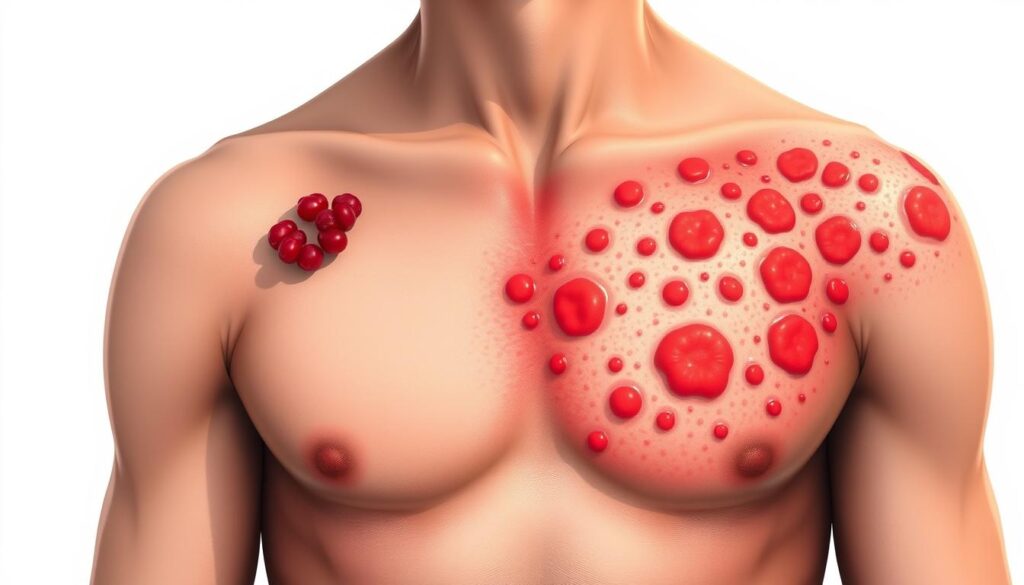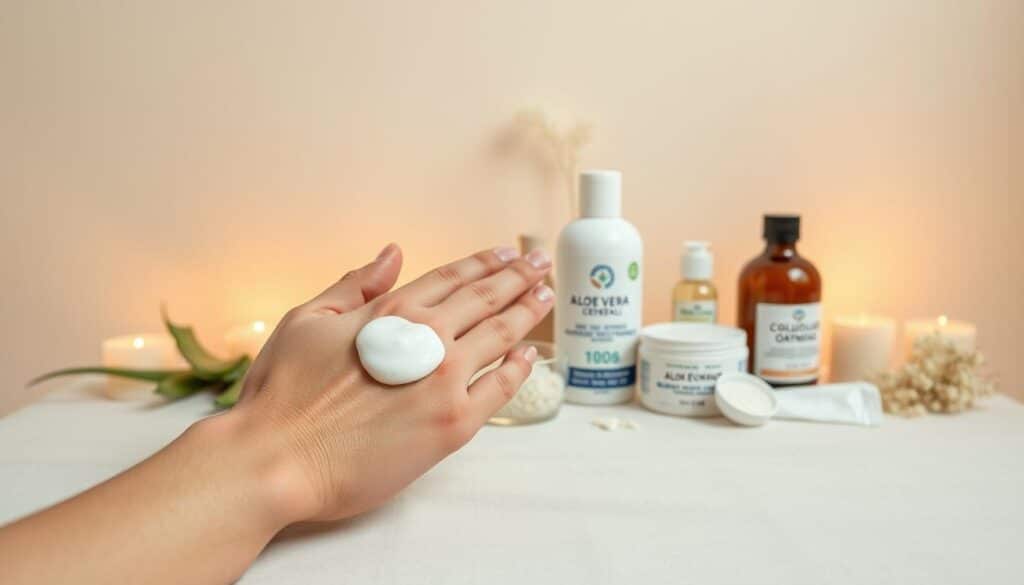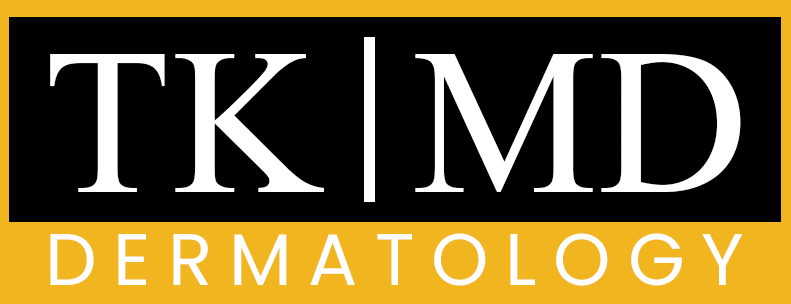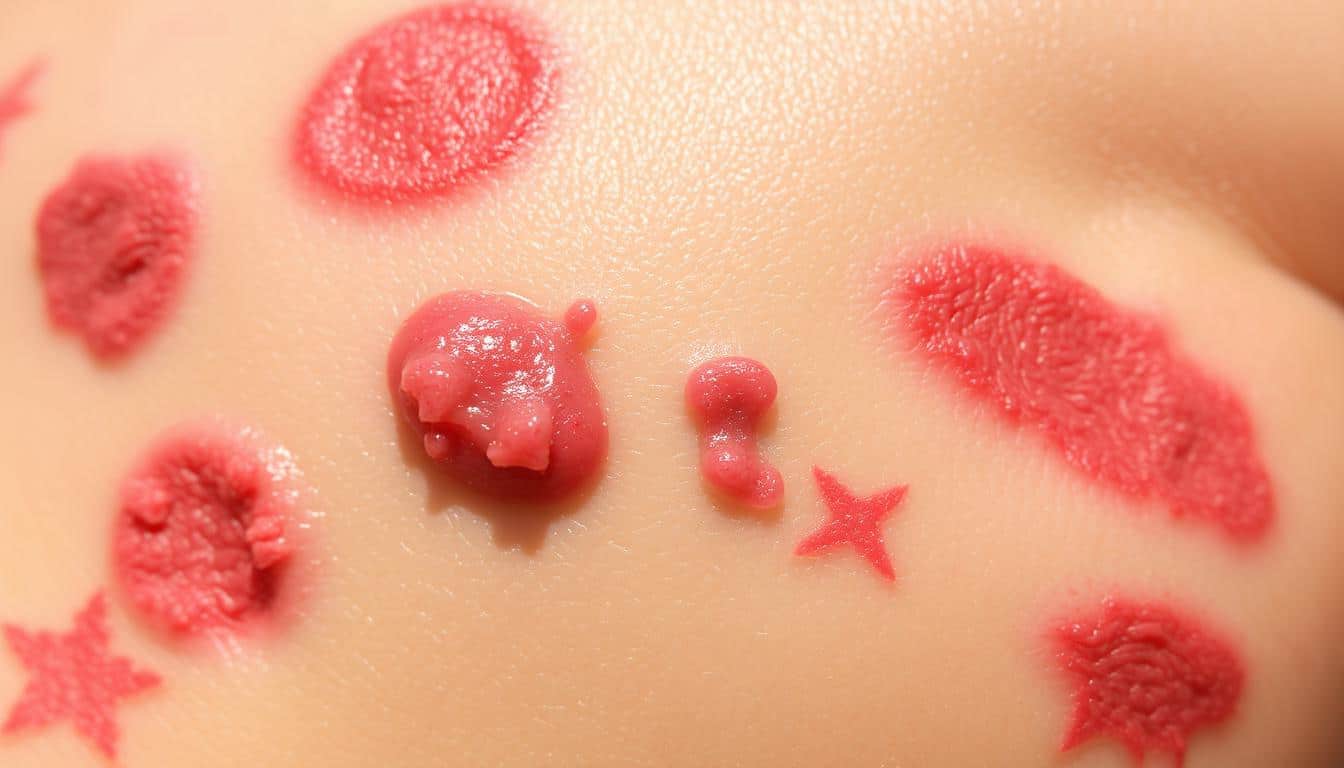Dealing with a sudden skin issue can be really tough. I once saw a rash on my skin and wasn’t sure if it was shingles or eczema. It was really hard to figure out what was happening to my body.
Shingles and eczema are two different skin problems that can hurt a lot. They might look the same at first, but they are not the same. At TK Dermatology, we know how important it is to find out what’s wrong and treat it right.
About 1 in 3 adults will get shingles at some point, with most cases happening after 60. Eczema affects 10% to 20% of kids and 1% to 3% of adults worldwide. Knowing the difference between these conditions is key to feeling better.
Key Takeaways
- Shingles and eczema are distinct skin conditions with different origins
- Accurate diagnosis is essential for effective treatment
- Age and symptoms play a critical role in identifying the condition
- Both conditions can significantly impact quality of life
- Professional medical consultation is recommended for proper diagnosis
For personalized care and expert diagnosis, call TK Dermatology at (407) 555-1234. Our team is here to help you understand your skin issue and find the right treatment.
Understanding Shingles and Eczema: Key Differences
Dealing with skin conditions can be tough, like telling shingles and eczema apart. They both affect the skin but are very different.
Common Misconceptions About Both Conditions
Many people mix up shingles and eczema because they look similar. But there are big differences:
- Shingles comes from the chickenpox virus coming back
- Eczema is a long-lasting skin problem that affects many in the U.S.
- Shingles can spread, but eczema can’t
Impact on Quality of Life
Both can mess up your daily life. Shingles often causes more pain and can lead to lasting nerve problems.
| Condition | Prevalence | Primary Symptoms |
|---|---|---|
| Shingles | Most common in people over 50 | Painful rash, blisters on one side of body |
| Eczema | 31 million Americans affected | Red, dry, itchy skin patches |
When to Seek Medical Attention
Seeing a doctor fast is important for both. For shingles, quick treatment can lessen the pain and stop serious problems. With eczema, a doctor’s advice helps control long-term symptoms.
Early treatment is key to managing skin conditions and preventing long-term health issues.
What Causes Shingles to Develop
The varicella-zoster virus, which causes chickenpox, can stay hidden in nerve tissue for years. It can wake up and cause shingles later in life. This is why some people get shingles when they’re older.
Shingles happens when the chickenpox virus comes back to life. This usually happens because of certain risk factors:
- Advanced age (over 50 years)
- Weakened immune system
- High stress levels
- Chronic medical conditions
“Nearly 1 in 3 people in the US will experience shingles during their lifetime after recovering from chickenpox.”
People with weakened immune systems are at a higher risk of getting shingles. This includes those with cancer, HIV, or taking certain medicines.
| Age Group | Shingles Risk |
|---|---|
| 50-60 years | Moderate Risk |
| 60-70 years | High Risk |
| 70+ years | Very High Risk |
As we get older, our immune system gets weaker. This makes it more likely for shingles to occur. Getting vaccinated is the best way to prevent this painful condition.
The Root Causes of Eczema Outbreaks
Eczema is a complex skin condition with many causes. Knowing what causes it can help manage symptoms. We explore how genetics, environment, and the immune system work together in eczema.
Genetic Predisposition
Genetics play a big role in eczema risk. Kids with parents who have eczema are more likely to get it. Specific genetic variations affect the skin barrier and immune system response.
- Family history increases eczema likelihood
- Inherited genetic traits affect skin sensitivity
- Certain gene mutations contribute to immune system dysfunction
Environmental Triggers
External factors can greatly affect eczema outbreaks. Common triggers include:
| Trigger Category | Specific Examples |
|---|---|
| Irritants | Soaps, detergents, fragrances |
| Allergens | Pollen, dust mites, pet dander |
| Climate Factors | Cold, dry weather, extreme temperatures |
Immune System Dynamics
The immune system is key in eczema. An overactive immune response causes inflammation and rash. About 10-20% of kids and 1-3% of adults worldwide deal with this.
“Eczema is not just a skin condition, but a reflection of complex immune system interactions.” – Dermatology Research Institute
Knowing the causes helps people manage eczema better. It reduces painful and uncomfortable outbreaks.
Recognizing Shingles Symptoms
Shingles has unique symptoms that can be hard to spot. It often starts with strange skin feelings that warn of an outbreak. Almost 1 million Americans get shingles each year, with those over 50 being most at risk.

- Tingling or burning sensations on one side of the body
- Unusual skin sensitivity
- Localized pain before rash appearance
- Flu-like symptoms without fever
The rash of shingles looks different. It begins as small red bumps that turn into painful blisters. These blisters form in a band-like shape, usually on one side of the torso or face.
“The shingles rash is a telltale sign of viral reactivation, appearing dramatically on a specific body region.” – CDC Dermatology Research
Shingles blisters go through a clear stage:
| Stage | Description | Duration |
|---|---|---|
| Initial Bumps | Red, small irritated areas | 1-2 days |
| Blister Formation | Fluid-filled painful blisters | 3-5 days |
| Scabbing | Blisters crack and begin healing | 7-10 days |
| Healing | Scabs fall off naturally | 2-4 weeks |
If you have ongoing pain or a rash that spreads, see a doctor. Starting antiviral meds early can make shingles symptoms less severe and shorter.
Identifying Eczema Signs and Symptoms
Eczema is a tough skin condition that affects millions globally. Our guide will help you spot the signs and symptoms of this complex rash. You’ll learn about its different forms and how it affects daily life.
The eczema rash has unique signs that make it different from other skin issues. Knowing these signs can help you manage your symptoms better.
Common Areas of Skin Involvement
Eczema often hits certain body parts harder than others. Kids and adults usually see it in:
- Face and neck
- Inside of elbows
- Behind knees
- Hands and feet
- Wrists and ankles
Types of Eczema Rashes
There are different kinds of eczema rashes, each with its own look. Our experts have listed the main types:
| Rash Type | Key Characteristics | Typical Appearance |
|---|---|---|
| Atopic Dermatitis | Most common form | Dry, itchy, red patches |
| Contact Dermatitis | Triggered by irritants | Localized red, swollen skin |
| Dyshidrotic Eczema | Small fluid-filled blisters | Tiny bumps on hands/feet |
If you have itchy skin or a rash that keeps coming back, see a dermatologist. They can give you the right diagnosis and treatment plan.
Understanding your skin’s unique signals is the first step toward effective management and relief.
Shingles or Eczema: Making the Distinction
It can be hard to tell shingles from eczema. Both cause skin problems, but they are different. This guide will show you how to spot the differences.
Shingles and eczema have unique signs. Skin conditions like these need close watching to figure out what they are.
| Characteristic | Shingles | Eczema |
|---|---|---|
| Pain Sensation | Intense, burning pain | Persistent itching |
| Rash Distribution | Localized to one side of body | Widespread, multiple areas |
| Duration | 2-4 weeks | Chronic, recurring episodes |
Looking at the symptoms shows the main differences:
- Shingles causes a painful rash with blisters
- Eczema is dry and itchy
- Shingles shows up as a band on one side of the body
- Eczema can be all over the body
Knowing the differences between shingles and eczema is key for the right treatment.
About 1 in 3 people will get shingles at some point. Eczema affects 10-20% of kids and 3% of adults. Shingles risk goes up after 50.
If you have ongoing skin problems, see a dermatologist. They can give the right diagnosis and treatment. This helps avoid complications from these tough skin issues.
Treatment Options for Shingles
Shingles is a painful condition that affects about 1 million people in the U.S. each year. Our guide will help you find the best ways to manage this viral infection. This way, you can lessen its impact on your health.
Antiviral Medications: Your First Line of Defense
Early treatment is key when dealing with shingles. Antiviral medication is a major part of managing the disease. These drugs help:
- Shorten the outbreak
- Lessen symptoms
- Stop complications
Doctors usually start antiviral meds within 72 hours of the rash showing up. The most used drugs are acyclovir, valacyclovir, and famciclovir.
Comprehensive Pain Management Strategies
Managing pain is vital when treating shingles. The pain can be severe, often from postherpetic neuralgia. This is a chronic pain that can last long after the rash goes away.
| Pain Management Approach | Recommended Options |
|---|---|
| Over-the-counter medications | Acetaminophen, Ibuprofen |
| Prescription pain relief | Lidocaine patches, Gabapentin |
| Alternative treatments | Acupuncture, Gentle massage |
Recovery Timeline and Expectations
Recovery from shingles usually takes 3 to 5 weeks. But, some people may have lasting symptoms or complications like postherpetic neuralgia. It’s important to follow your doctor’s advice and finish all treatment for the best recovery.
“Early treatment can significantly reduce the severity and duration of shingles symptoms.” – CDC Recommendation
Our team suggests talking to a healthcare professional. They can create a treatment plan that fits your needs and medical history.
Managing Eczema Effectively

Living with eczema can be tough, but we have ways to help. Our strategies can make itchy skin better and cut down on rash outbreaks. Eczema is a long-term condition that needs ongoing, tailored care.
Effective eczema management involves several steps:
- Identifying and avoiding individual triggers
- Maintaining a rigorous skincare routine
- Using specialized moisturizers
- Implementing stress reduction techniques
For those with persistent eczema, there are many treatment options:
- Topical treatments: Corticosteroid creams
- Immunomodulator medications
- Systemic medications for severe cases
- Phototherapy
“Consistent care and patience are key to managing eczema symptoms effectively.”
Our research indicates that about 31 million Americans have eczema. Symptoms can range from mild to severe. Knowing your triggers and working with dermatologists can greatly improve your life.
Here are some key tips for managing eczema:
- Using moisturizers containing ceramides
- Practicing stress management techniques
- Controlling environmental factors
- Maintaining a consistent skincare routine
While there’s no cure for eczema, managing it well can greatly reduce itchy skin and rash outbreaks.
Prevention Strategies for Both Conditions
To avoid shingles and eczema, you need to take care of your health. Knowing how to prevent each condition can lower your risk of outbreaks. This can also help avoid serious problems.
Lifestyle Modifications for Prevention
Changing your lifestyle can help prevent shingles and eczema. If you’re at higher risk, like if you’re immunocompromised, it’s even more important to take action.
- Eat a diet full of nutrients that boost your immune system
- Try stress-reducing activities like meditation and yoga
- Make sure you get enough sleep to keep your immune system strong
- Stay away from things that can trigger eczema
- Keep clean to lower the chance of chickenpox coming back
Vaccination and Protection
Vaccination is the best way to prevent shingles. The Shingrix vaccine gives over 90 percent protection. If you’re 50 or older, getting vaccinated is a must.
“Prevention is always better than cure, when it comes to shingles and eczema.” – Dermatology Experts
Additional Prevention Recommendations
If you’ve had chickenpox, knowing your risk is key. About one in three adults who had chickenpox will get shingles, mainly as they get older.
- Talk to your doctor about your risk
- Watch your skin for any changes and see a doctor early
- Learn about your family’s history of eczema
- Manage any long-term health issues that might make you more vulnerable
By following these steps, you can greatly lower your risk of shingles or eczema outbreaks. This can make your life much more comfortable.
Complications and Long-term Effects
Shingles can cause serious long-term health issues, mainly for those with weakened immune systems. The biggest worry is postherpetic neuralgia (PHN). This is a severe nerve pain that lasts long after the rash goes away.
It’s important to know about these complications to take care of your health. Some long-term effects include:
- Postherpetic neuralgia affecting 10-18% of shingles patients
- Potential vision problems with herpes zoster ophthalmicus
- Increased risk of complications for adults over 50
- Potential nerve damage and chronic pain
For those with weakened immune systems, the risks are even higher. About 1 in 3 people will get shingles at some point. Those with weaker immune systems face a higher risk of complications.
“The severity of shingles complications highlights the need for early detection and treatment.” – Dermatology Research Institute
Nerve pain from PHN can be very hard to deal with. While shingles symptoms usually go away in 2-4 weeks, PHN can last for months or even years. This can really affect your quality of life.
| Age Group | PHN Risk | Potential Complications |
|---|---|---|
| Under 40 | Very Low | Minimal long-term effects |
| 50 and Older | Highest Risk | Increased nerve pain, possible vision problems |
We suggest talking to a healthcare professional. They can help you understand your risk and plan how to manage any complications from shingles.
When to Contact Our Dermatology Team
Dealing with skin issues like shingles and eczema can be tough. We know how vital it is to get medical help fast. This helps avoid serious problems and keeps your skin healthy.
It’s key to know when to get professional help for skin problems. Some symptoms need quick action to avoid long-term issues with shingles or eczema.
Warning Signs Requiring Immediate Medical Attention
- Rash spreading rapidly across the body
- Intense pain or burning sensation
- Blisters near sensitive areas like eyes or mouth
- Fever accompanying the rash
- Signs of possible infection
Available Treatment Locations
Our expert dermatology team is ready to help at several locations:
- Orlando Clinic: Offers full skin care services
- Clermont Office: Has advanced diagnostic tools
- The Villages Center: Focuses on geriatric dermatology
Emergency Situations
Shingles and severe eczema can get worse fast. Quick medical help is essential if you see:
- Widespread, painful rash
- Potential systemic infection
- Immune system not working right
“Early detection and treatment can significantly improve outcomes for skin-related conditions.” – Dermatology Experts
Call our dermatology team at (XXX) XXX-XXXX for fast help with shingles, eczema, or any rash that won’t go away.
Treatment Centers in Orlando, Clermont, and The Villages
TK Dermatology offers top-notch care for shingles and eczema in Central Florida. Our team uses special treatments for these skin issues.
Managing shingles and eczema needs a personal touch. Our clinics in Orlando, Clermont, and The Villages have the latest tools. They help patients find relief.
Our Service Locations
- Orlando: Central Treatment Center
- Clermont: Specialized Skin Care Clinic
- The Villages: Senior Dermatology Care
Treatment Offerings
| Location | Shingles Services | Eczema Services |
|---|---|---|
| Orlando | Antiviral Treatments | Comprehensive Skin Assessment |
| Clermont | Pain Management | Customized Treatment Plans |
| The Villages | Senior-Focused Care | Immunomodulator Therapies |
Dr. Usha Jain, with 30 years of experience, leads our team. We offer quick appointments and special care for shingles or eczema.
“Our mission is to provide compassionate, cutting-edge dermatological care tailored to each patient’s unique needs.”
Contact Information
- Phone: (555) 123-4567
- Email: appointments@tkdermatology.com
- Website: www.tkdermatology.com
Patients in zip codes 32819, 32811, 32821, and nearby can visit us. We suggest a consultation for your shingles or eczema concerns.
Conclusion
Understanding shingles and eczema is key. Almost one in three people in the US will get shingles. Atopic dermatitis, or eczema, affects 18 million Americans. It’s vital to get the right treatment for both conditions.
We’ve looked at the main differences between shingles and eczema. Shingles can happen to 20% of people who had chickenpox. And 40% of those with eczema have severe symptoms. Getting help early can make a big difference.
At TK Dermatology, we focus on your skin health. Our experts are here to help with shingles and eczema. Don’t let skin issues take over your life. Call us today at our locations in Orlando, Clermont, or The Villages. Your skin’s health is our main concern.
If you’re dealing with eczema or worried about shingles, we’re here for you. Our team offers caring and complete care. Book your consultation and start on the path to better skin.


